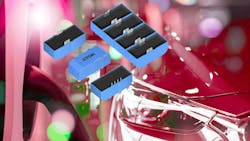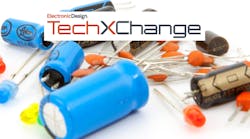Modular Capacitors Smooth Out Power from High-Voltage EV Batteries
The DC-link capacitor is a cornerstone of traction inverters under the hood of EVs. These passive components are used to smooth out and steady DC voltages traveling from the battery into the inverter.
Such capacitors also limit decoupling spikes and any other ripples in the voltage caused by the rapid switching of the MOSFETs or IGBTs at the heart of the power supply under changing load conditions. Thus, they directly impact the system’s power efficiency and density.
TDK introduced a set of modular building blocks for DC-link capacitors called xEVCap to adapt these components to the specific needs of the system. Featuring a minimal amount of resistance (ESR) and inductance (ESL), these passives target traction inverters in passenger, commercial, and off-highway EVs. With voltage ratings of 500, 650, 850, and 920 V, the xEVCap capacitors can also handle the furiously fast switching speeds of SiC MOSFETs and GaN power FETs, said TDK.
The new family of film capacitors are rated for currents ranging from 35 to 60 A, at 10 kHz, with ESL ratings of 14 nH or 17 nH, at 1 MHz. Depending on the rated voltages, the parts support capacitances ranging from 60 to 270 µF.
>>Check out these TechXchanges and Series Library for similar articles and videos
To handle different amounts of capacitance and current, several of the xEVCaps can be connected in parallel and embedded on circuit boards with all of the other power electronics in the traction inverter, or attached to the busbars used to distribute power around the EV. TDK said customers are able to connect more xEVCap capacitors to reduce inductance and increase performance, or they can combine a smaller number of them to save space.
DC-Link Capacitors: What Role Do They Play in the EV?
At the heart of every modern EV is a high-voltage battery pack that operates from 48 V DC to as high as 800 V. The higher the DC operating voltage, the less current is required to supply the same output power, which correlates to higher performance.
The traction inverter converts the high-voltage DC from the battery pack to the three-phase AC voltage used to drive the electric motor during acceleration and then converts the AC back to DC during braking. The DC-link capacitor is one of the core building blocks of the system, acting as the intermediary buffer between the battery and load. It’s also widely used in solar and other renewable-energy systems connected to the grid.
In general, these inverters feature three power stages comprised of high-frequency IGBTs that each produce a different voltage level: positive (+V DC), negative (−V DC), and zero (0 V). By using these three voltage levels, the system can produce a more sinusoidal output voltage with less harmonic distortion. The smoother output waveform grants higher efficiency, which makes more of a difference when handling large amounts of power. The inverters contain one or more DC-link capacitors to stabilize the voltage traveling over the DC bus.
The DC-link capacitor is placed in parallel between the inverter’s input stage that connects to the high-voltage EV battery and the power FETs on the output stage. Its main function is to smooth out the DC voltage flowing from one side to the other. The device removes ripples caused when the system suddenly demands heavy current—for instance, during startup and acceleration—and manages the stray inductance on the DC bus. These fluctuations could cause problems with power quality, which can take a toll on the EV’s efficiency and range.
DC-link capacitors are also used to identify sudden increases in voltage and dampen them to protect the power electronics in the EV. They can serve as filters to manage electromagnetic interference (EMI) as well.
xEVCap: Modular Components for DC-Link Capacitors
With EV power levels rising, the DC-link capacitor is becoming more of a make-or-break component.
The DC-link capacitor must be able to store significant amounts of energy and handle rapid changes in the voltage, current, and temperature. Under-design it, and the DC-link capacitor can lead to a premature failure or negatively impact the performance of the EV power electronics. Over-design it, and the component can be too bulky and costly for the system.
As a result, such capacitors are rarely off-the-shelf components. Instead, they must be custom designed to fit the specific requirements of the system, which can drag out the design process.
TDK is trying to replace traditional power electronics with its xEVCap technology, which is more modular and flexible. The capacitors come in standard form factors, including 85 × 47 × 40.5 mm, 97.5 × 35.5 × 42.5 mm, and 109 × 47 × 40.5 mm. They can be connected in several different ways: the B25654A*001 has lead wires for soldering to busbars or circuit boards, while the B25654A*002 features flat terminals for welding or screwing to busbars.
The xEVCap family is focused on high reliability and robustness. TDK said xEVCap can handle higher voltages than its rating for a limited time: the capacitors rated for 850 V can tolerate up to 890 V for 100 hours at 105°C and sudden jolts of up to 1,200 V.
These modular capacitors are also designed to handle the rigors of the road, said TDK. They can all tolerate temperatures from -40 to 100 °C, and they meet the latest automotive AEC-Q200 and IEC TS 63337 standards.
>>Check out these TechXchanges and Series Library for similar articles and videos
About the Author
James Morra
Senior Editor
James Morra is the senior editor for Electronic Design, covering the semiconductor industry and new technology trends, with a focus on power electronics and power management. He also reports on the business behind electrical engineering, including the electronics supply chain. He joined Electronic Design in 2015 and is based in Chicago, Illinois.





